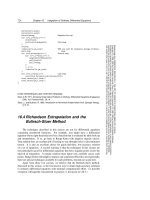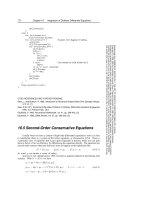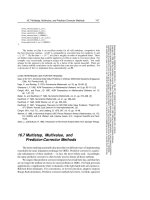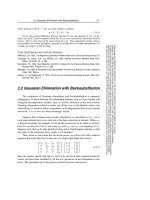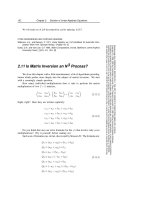Tài liệu PATHWAYS OF ORGANIC CHEMICAL CONTAMINATION IN ECOSYSTEMS pdf
Bạn đang xem bản rút gọn của tài liệu. Xem và tải ngay bản đầy đủ của tài liệu tại đây (225.55 KB, 7 trang )
UNESCO – EOLSS
SAMPLE CHAPTERS
ENVIRONMENTAL AND ECOLOGICAL CHEMISTRY – Vol. III – Pathways of Organic Chemical Contamination in
Ecosystems - Padma T. Venkatraman
©Encyclopedia of Life Support Systems (EOLSS)
PATHWAYS OF ORGANIC CHEMICAL CONTAMINATION IN
ECOSYSTEMS
Padma T. Venkatraman
College of William and Mary, USA
Keywords: Persistent Organic Pollutants, Global transport, Enantiomer ratios, Stable
isotopes.
Contents
1. Introduction
2. Sources and Input of Organic Pollutants to the Environment
2.1. Diffusive versus Point Sources
2.2. Important Classes of Organic Pollutants
2.3. Degradable versus Persistent Pollutants
2.4. Pollutants of Emerging Concern
2.5. Compounds and Mixtures
3. Transport pathways within ecosystems
3.1. Effect of Chemical Properties
3.2. Environmental Factors Affecting Transport
4. Degradation pathways
4.1. Photodegradation
4.2. Hydrolysis
4.3. Biodegradation
5. Spatial scales of pollutant transport pathways
5.1. Local Transport
5.2. Regional Transport
5.3. National Scale
5.4. Continental Scale
5.5. Global Transport
5.5.1. Evidence in Support of Global Distillation
5.5.2. Cold Condensation and Accumulation
5.5.3 Significance of Global Transport
6. Use of geochemical tracers to track contaminant pathways through ecosystems
6.1. Isomer Ratios
6.1.1. Measurement of Isomer Ratios
6.1.2. Use of Isomer Ratios to Study Contaminant Pathways
6.2. Enantiomer Ratios
6.2.1. Measurement of Enantiomer Ratios
6.2.2. Use of Enantiomer Ratios to Study Contaminant Pathways
6.3. Stable Isotope Ratios
6.3.1. Measurement of Stable Isotope Ratios
6.3.2. Use of Elemental Stable Isotope Ratios to Study Contaminant Pathways
6.3.3. Use of Compound Specific Stable Isotope Ratios (CSIRs) to Study
Contaminant Pathways
7. Future directions
UNESCO – EOLSS
SAMPLE CHAPTERS
ENVIRONMENTAL AND ECOLOGICAL CHEMISTRY – Vol. III – Pathways of Organic Chemical Contamination in
Ecosystems - Padma T. Venkatraman
©Encyclopedia of Life Support Systems (EOLSS)
8. Conclusions
Acknowledgements
Glossary
Bibliography
Biographical Sketch
Summary
This chapter examines the fate, transport and degradation pathways of organic
anthropogenic chemicals in ecosystems at different spatial scales, ranging from local to
global with an emphasis on the use of molecular markers to study such pathways. Sources
of pollutants, those that are likely to be of concern in the near future, predominant
degradation pathways and how these affect different classes of pollutants is mentioned. The
inter-relationships among the physical-chemical properties of compounds and mixtures, the
biogeochemical environment into which they are released, and their resulting fate are also
briefly discussed. The focus of the chapter, however, is recently developed geochemical
tracer tools that allow us to track the pathways of contaminant fate and transport within and
between ecosystems.
1. Introduction
Ever since Rachel Carson’s book Silent Spring was published, there has been heightening
awareness and concern about the persistence and biological effects of anthropogenic
contaminants. Although industrialized nations have attempted to ban the use of some
persistent and toxic pollutants within their own jurisdictions, many multi-national as well
as local companies continue to manufacture them for use in less industrialized nations
where such chemicals may still be used due to lack of education or conflicting economic
and health interests. For example, in tropical nations, the adverse health conditions that
may be caused by outbreaks of malaria or other diseases carried by mosquito vectors
necessitate the use of the pesticide dichloro diphenyl trichloroethane (DDT), whose toxic
effects and persistence are well known. Complete elimination of DDT will not be feasible
until cheap but reliable options are developed for effective control of tropical diseases such
as malaria.
Many classes of compounds including organochlorine pesticides such as DDT, polycyclic
aromatic hydrocarbons (PAHs), polychlorinated biphenyls (PCBs), polychlorinated
dibenzo-p-dioxins (PCDDs) and polychlorinated dibenzofurans (PCDFs) are considered
persistent organic pollutants or POPs. These pollutants degrade relatively slowly under
typical environmental conditions and hence are persistent in the environment. They
generally undergo bioaccumulation and bioconcentration and exert various sublethal effects
such as endocrine disruption, immunological and neurological dysfunctions, reduced
reproductive success, genotoxicity and teratogenicity. Many are suspected or known
carcinogens. POPs have been implicated in serious health effects on human children such
as growth retardation.
In the mid nineteen eighties, the World Health Organization (WHO) estimated that the
annual death toll due to direct or indirect effects associated with POPs. In the mid nineteen
nineties, the United Nations Environmental Program (UNEP) called for international
UNESCO – EOLSS
SAMPLE CHAPTERS
ENVIRONMENTAL AND ECOLOGICAL CHEMISTRY – Vol. III – Pathways of Organic Chemical Contamination in
Ecosystems - Padma T. Venkatraman
©Encyclopedia of Life Support Systems (EOLSS)
assessment of the “dirty dozen.” Recently, an inter-governmental negotiating committee
formulated a treaty on POPs, despite opposition from a coalition of certain industrialized
nations that tried to label the text of the treaty “unscientific.” This international treaty on
POPs is now scheduled to be signed in May of the year two thousand and one, in
Stockholm.
In light of the fact that POPs that have been used in great quantities all over the globe in the
past and that some are still used in parts of the world today, it is important to develop
techniques to quantify their fate and transport pathways. It is also necessary to develop
tools that can track contaminant pathways of non-POPs, in order to better assess the risks
they pose to different parts of the ecosystem under consideration. Such methods when used
in conjunction with research on the manner in which physical and chemical properties of
chemicals affect their environmental behavior, could help to identify undesirable and
desirable characteristics of synthetic chemicals and thus become an invaluable guide to the
design and manufacture of “green” chemicals in the future.
2. Sources and Input of Organic Pollutants to the Environment
2.1. Diffusive versus Point Sources
Sources of contaminants to the environment may be classified into two broad categories:
diffusive and point sources. A pollutant is said to have a point source when its input into
the environment is from a discrete unit. When a pollutant does not emanate from one or a
few clearly distinguishable point sources, it may be considered to have a diffusive source.
Point sources are specific locations that may be pin-pointed as the source, for example a
particular industrial plant that exclusively produces a certain chemical. If such a plant is the
only one located in a certain region such as the bank of an estuary, for instance, and
discharges wastes into this estuary, this plant can be located as the source of the chemical.
Sewage out falls are another example of a point source.
Diffusive sources are sources that may not be clearly singled out or located on a map.
Certain PAHs find their way into the atmosphere as a result of automobile exhaust, in
which case they can be said to have a diffusive source because they are not entering into the
environment from a discrete entity. Another good example of a diffusive source would be
pollutants present in runoff. In general, a pollutant may be considered to have a diffusive
source within a particular ecosystem or region when there is no one or small set of discrete
locations such industrial out falls that can be pointed out as the primary source(s) for that
particular chemical in the environment under study.
2.2. Important Classes of Organic Pollutants
PAHs are predominantly emitted into the atmosphere by the incomplete combustion of
fossil fuels. Some PAHs also have natural sources (petroleum formation, seeps, etc.) PCBs
are generally stable at high temperatures and thus used in transformers, capacitors and as
flame retardants. PCDDs are by products produced during paper bleaching processes and
hence they are often found in pulp and paper mill effluents. They were also by-products
during the manufacture of Agent Orange. These chemicals are generally emitted into the
UNESCO – EOLSS
SAMPLE CHAPTERS
ENVIRONMENTAL AND ECOLOGICAL CHEMISTRY – Vol. III – Pathways of Organic Chemical Contamination in
Ecosystems - Padma T. Venkatraman
©Encyclopedia of Life Support Systems (EOLSS)
atmosphere via waste incineration and other industrial activities.
Agrochemicals are another source of contaminants to the environment. Organochlorine
pesticides such as lindane, -hexachlorocyclohexane and DDT are used for mosquito and
crop-related pest control in many countries. The high degree of chlorination of these
pesticides rendered them relatively resistant to microbial attack and also tended to impart a
broad spectrum of toxicity to these pesticides, rendering them dangerous not only to
insects but also to higher animals including mammals such as humans. Newer generations
of pesticides such as organophosphorus pesticides and acetamide pesticides are usually
more specifically targeted in terms of mode of action, and often less persistent.
Organometallic compounds such as tributyl tin (TBT) were usually produced and added to
paints in order to prevent bio-fouling of objects placed in or often in contact with water
(such as piers, ships etc). TBT is highly toxic, and leaches into seawater, where it is known
to bioaccumulate and cause a variety of undesirable effects on aquatic organisms (such as
disruption of reproduction by causing imposex in bivalves).
Some of highly volatile pollutants are industrial solvents such as carbon tetrachloride,
benzene. Trichloroethane, which is used as a dry cleaning fluid is also soluble and volatile.
These pollutants often cause groundwater contamination and also reach aquatic and
terrestrial bodies through air-water or air-land exchange processes. Chlorinated
fluorocarbons such as freons that were used in refrigeration and as flame retardants are
among the most volatile of anthropogenic pollutants.
Another important class of organic pollutants that has a unique set of chemical properties is
that of surfactants, which are commonly used in detergents. These chemicals are amphilic
i.e. they have a hydrophilic end as well as a hydrophobic functional group. This unique
“dual” nature has implications for their fate and transport.
2.3. Degradable versus Persistent Pollutants
The distinction between degradable and persistent pollutants is somewhat arbitrary. In
general a pollutant that tends to have residence times on the order of decades may be
considered highly persistent, and one that degrades on the order of hours or days may be
considered “degradable.” When laboratory studies claiming “degradability” are evaluated,
it is extremely important to carefully compare the conditions under which the study was
conducted with the conditions that will be faced by the pollutant in the environment, as
persistence as well as toxicity may be affected by physico-chemical parameters of the
environment as discussed in a following section. The notion of persistence must also take
into account the chemical’s inherent properties. A chemical that may be mineralized by a
laboratory culture of bacteria within a few days, may persist in the environment if it is
highly volatile and thus is not retained for considerable periods of time by aquatic or
terrestrial bodies in which such reactions take place.
2.4. Pollutants of Emerging Concern
It has been recognized for the past few decades that POPs are ubiquitous and worthy of
study. However, some other pollutant classes have not been studied in as much detail.
UNESCO – EOLSS
SAMPLE CHAPTERS
ENVIRONMENTAL AND ECOLOGICAL CHEMISTRY – Vol. III – Pathways of Organic Chemical Contamination in
Ecosystems - Padma T. Venkatraman
©Encyclopedia of Life Support Systems (EOLSS)
Pollutants that may require attention in the future are surfactants and pharmaceuticals.
Recent work on surfactants such as nonylphenols has shown that these chemicals may
cause endocrine disruption events. Since surfactants are present in soaps and detergents that
are used as household products, they are likely to be present in high quantities in the
environment.
Pharmaceuticals and their metabolites are also likely to be associated with high biological
activity and may be present in the environment at concentrations high enough to cause
action. Very little is known about the occurrence, distribution and pathways of these
contaminants in terrestrial and aquatic ecosystems in most parts of the world. Research in
this area is beginning to gain some importance on the American continent, and has been
receiving attention in Europe. It is an area that requires investigation in the future.
2.5. Compounds and Mixtures
Although some sources of contaminants emit solely or predominantly one type of
compound into the environment, contaminants usually find their way into the environment
as mixtures. Creosote or coal tar distillate, for example, is a chemical mixture composed
primarily of aromatic hydrocarbons.
Industrial formulations of pesticides are often mixtures of closely related chemicals. For
instance, commercial formulations of chlordane and technical hexachlorocylcohexane
contain mixtures of different isomers of chlordane and closely related compounds, such as
cis-chlordane, trans-chlordane etc.) and hexachlorocyclohexanes (HCHs), such as -, -, -,
and - HCH, respectively.
Mixtures may be composed of mainly one class of chemicals like the examples given
above, or else may contain many different classes of compounds. Sewage wastes may
include not only nutrients such as nitrogen and phosphorus that may result in
eutrophication of aquatic ecosystems if the sewage is untreated, but also high
concentrations of household chemical by-products (such as nonyl-phenols, which are
endocrine disrupting pollutants found in detergents) as well as pharmaceutical wastes and
toxic metabolites of pharmaceutical chemicals.
3. Transport Pathways within Ecosystems
The pathways available for transport of a pollutant within ecosystem compartments and
between ecosystems depend on the mode by which a pollutant is discharged into the
environment. For example, particles of soot that are first emitted into the atmosphere during
incineration, may then undergo washout, rain out or precipitation out of the atmosphere and
onto soils or water bodies. Transport pathways available to effluents include volatilization,
sorption to particles in the water body, dissolution etc. The predominant mechanism of
transport depends primarily on the chemical properties of the pollutant itself and on the
physical, chemical and biological characteristics of the environment into which it is
released. For a detailed discussion on the inter-relationships among various chemical
properties and environmental processes, the reader is referred to the text by Schwarzenbach
and others.
UNESCO – EOLSS
SAMPLE CHAPTERS
ENVIRONMENTAL AND ECOLOGICAL CHEMISTRY – Vol. III – Pathways of Organic Chemical Contamination in
Ecosystems - Padma T. Venkatraman
©Encyclopedia of Life Support Systems (EOLSS)
-
-
-
TO ACCESS ALL THE 20 PAGES OF THIS CHAPTER,
Visit:
Bibliography
Bidleman T. F., and Falconer R. L. (1999). Enantiomer ratios for apportioning two sources of chiral
compounds. Environ. Sci. Technol. 33, 2299-2301. [A short paper clearly explaining how to use ERs to
evaluate environmental sources and processes].
Faller J., Huehnerfuss H., Koenig W. A., and Ludwig P. (1991). Do marine bacteria degrade alpha-
hexachlorocyclohexane stereoselectively? Environ. Sci. Technol. 25, 676- 678. [A seminal paper on
enantioselective separations of environmental compounds].
Hallig-Sørensen B., Nielsen S. N., Lanzky P. F., Ingerslev F., Lütshøft H. C. H., and Jørgensen S. E. (1998).
Occurrence, fate and effects of pharmaceutical substances in the environment: a review. Chemosphere 36,
357-393. [A review of pharmaceuticals as emerging environmental pollutants of concern].
Hoefs J. (1997). Stable Isotope Geochemistry. Springer-Verlag, New York. [This provides a thorough
grounding in the basic concepts behind stable isotope techniques in environmental geochemistry].
Hühnerfuss H., Faller J., Kallenborn R., König W. A., Ludwig P., Pfaffenberger B., Oehme M., and Rimkus
G. (1993). Enantioselective and nonenantioselective degradation of organic pollutants in the marine
ecosystem. Chirality 5, 393-399. [A short review of enantiomeric ratios of eleven chiral environmental
pollutants in different marine ecosystems].
Kurtz D. A., Ed. (1990). Long-range transport of pesticides and other toxic substances, Lewis, Chelsea, USA.
[This contains many articles on various aspects of the global transport of POPs].
Lajtha K., and Michener R. H. (1994) Stable isotopes in ecology and environmental science. 316 pp.
Blackwell Scientific Publications, Oxford, UK. [This contains articles on the use of stable isotopes to
elucidate processes and distinguish sources in the environment and includes an excellent chapter by S. A.
Macko about compound-specific stable isotope use].
Landers D.H., and Christie S. J., Eds.(1995) Special Issue: Ecological Effects of Arctic Airborne
Contaminants. 160/161, 870 pp. Sci. Tot. Environ. [This presents many interesting articles by scientists that
have worked on various aspects of pollution in polar regions].
Schwarzenbach, R. P., Gschwend, P. M. and Imboden, D.M. (1993). Environmental organic chemistry, 681
pp. John Wiley & Sons, Inc., New York. [A clear and comprehensive assessment of the relationship among
various environmental factors, chemical properties and the fate and transport pathways of contaminants in
different ecosystems and ecosystem components].
Wanda, F.W. and Mackay, D. (1996). Tracking the distribution of persistent organic pollutants. Environ. Sci.
Technol. 30, 390A-396A. [A short and thorough analysis of existing data in support of the global distillation
hypothesis, along with an explanation of a theoretical model of the process and recommendations to managers
and policy makers].
Biographical Sketch
UNESCO – EOLSS
SAMPLE CHAPTERS
ENVIRONMENTAL AND ECOLOGICAL CHEMISTRY – Vol. III – Pathways of Organic Chemical Contamination in
Ecosystems - Padma T. Venkatraman
©Encyclopedia of Life Support Systems (EOLSS)
Padma T. Venkatraman completed her master’s research on the toxicity and environmental fractionation of
polycylic aromatic hydrocarbons present in creosote at the College of William and Mary. She then worked on
polychlorinated biphenyls in water, sediments and biota in the Baltic Sea. She has also worked on
nonylphenols. She has also conducted some research on the potential use of stable isotopes as tracing tools for
contaminant transport. Her currently research focuses on the fate and transport of chiral pollutants in estuarine
ecosystems.



